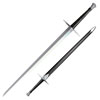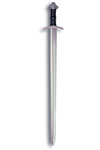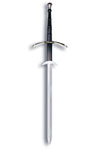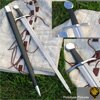|
|
|
 |
|
| Hanwei Saxon Sword 9th century (SH2436) |
Points: 25

|
CAS Hanwei’s smiths have outdone themselves with their recreation of a 9th Century Saxon sword by replicating a technique used by the Saxons and Vikings and producing a stunning blade that features a pattern-welded core with high-carbon edge sections. This technique was used by the old-time smiths as a means of producing blades (just for the rich folks) that were sharp, resilient and decorative and, eleven hundred years on, CAS Hanwei has made them affordable.
The sword’s design is based on a 9th Century piece found in the bank of a stream in England in 1976 and now on display in the Yorkshire Museum.
|
|
|
|
|
|
 |
|
| Cold Steel Hand And A Half Sword (88HNH) |
Points: 24
|
Reflects the highest standards in workmanship and materials and comes fully sharpened and ready for battle. Suitable for both a one or two handed grip. Handle is wood covered in black leather.To balance the long 33.5" blade, we have capped the butt with a beautiful "scent stopper" pommel. Overall length is 42-5/8". Scabbard is leather with steel fittings.
|
|
|
|
|
|
 |
|
| Cold Steel Hand And A Half Dagger (88HNHD) |
Points: 13
|
Hand And a Half Dagger by Cold Steel. We would be hard pressed to think of a more versatile or effective sword than the "Bastard" or "Hand-and-a-Half Sword" we offer here. For a sword of this size, it's amazingly light and fast and tips the scales at approximately 3 lbs. Its 33 1/2" long blade is quite wide so it can produce deep shearing type cuts yet pointed enough to be effective in a thrusting attack. Its long handle is suitable for both a one or two handed grip and is fashioned out of wood covered in black leather. To balance the long blade we have capped the butt with a beautiful "scent stopper" pommel which can be a lethal weapon in its own right.
|
|
|
|
|
|
 |
|
| Cold Steel Viking Sword (88VS) |
Points: 20

|
Features a double edge sharp blade, hand forged out of high carbon steel and then polished to a brilliant lustre. The wooden handle is covered in leather and is supported by a simple,elegant guard and an equally handsom 5 lobed pommel. Both guard and pommel feature tradiional Celtic knot decorative embellishments. Wood scabbard covered in black leather and reinforced with a highly polished steel chape and throat.
|
|
|
|
|
|
 |
|
|
|
|
 |
|
| Cold Steel Sword Norman Sword (88NOR) |
Points: 19
|
The Norman lust for battle and ravenous desire for land and treasure can, like their famous sword be undoubtedly traced to their Viking forefathers who wrenched their homeland in northwestern France from the hands of Charles the Simple in the Treaty of Saint-Clair-sur- Epte in 911 AD.
Never satisfied with thier lot, it wasn't long before they once again took up their broad, double- edged swords and set sail across the English Channel to conquer Britian most famously, at the battle of Hastings in 1066 AD.
|
|
|
|
|
|
 |
|
| Hanwei Early Medieval Single Hand - Tinker Pearce Sharp (SH2404) |
Points: 13

|
Early Medieval Sword designed by Michael `Tinker` Pearce and reproduced by Hanwei to his specifications.
The swords meet Tinker`s exacting quality requirements and are built in much the same way as his custom pieces. Each blade is forged from 5160 Spring Steel, Marquenched to the desired hardness of 50-53 Hrc while the tang is drawn back to the low 30s Hrc. The very end of the tang is threaded to fit an allen nut recessed into the pommel which allows for dimantling of the hilt assembly for inspection or to exchange blades if needed.
|
|
|
|
|
|
 |
|
| Hanwei Hand and a Half Sword - Tinker Pearce Sharp |
Points: 10

|
Bastard Sword designed by Michael `Tinker` Pearce and reproduced by Hanwei to his specifications.
The swords meet Tinker`s exacting quality requirements and are built in much the same way as his custom pieces. Each blade is forged from 5160 Spring Steel, Marquenched to the desired hardness of 50-53 Hrc while the tang is drawn back to the low 30s Hrc. The very end of the tang is threaded to fit an allen nut recessed into the pommel which allows for dimantling of the hilt assembly for inspection or to exchange blades if needed.
|
|
|
|
|
|
 |
|
| Hanwei Gustav Rapier (SH2206) |
Points: 12

|
The Gustav Rapier and Main Gauche replicate weapons used by King Gustav Adolf II, who ruled Sweden in the early part of the 17th century. The shell guard of the rapier is unusual but effective. Available in both bright and antiqued versions. A replacement live blade is also available (OH2327).
All of our rapiers have stainless steel hilts, for reduced maintenance, and high-carbon steel flex-tempered blades. Our three swept-hilt styles (Solingen, Torino, Gustav) are available with hilts in both polished and antiqued finishes. The latter finish, developed by Hanwei, has allowed a museum-quality patina to be applied to stainless steel while the non-corroding properties of the steel are retained. This finish is extremely attractive and gives a very authentic appearance to the piece.
The swept-hilt rapiers and their attendant main gauches have now been redesigned to provide lighter, better balanced pieces than earlier models. The hilts are now of the same size as the museum pieces on which they are based, providing an authentic "feel" in the user's hand. All of the rapier and main gauche blades shown on Pages 80, 81, 82 and 83 of the catalog are interchangeable with the "Practical" blades (OH2255 - rapier, OH2256 - Main Gauche), which are designed for safety in rapier sparring. This gives the user a wide choice of swept hilt styles for use with both live and "Practical" blades. A replacement live blade is also available (OH2327).
|
|
|
|
|
|
 |
|
| Hanwei Gustav Main Gauche (SH2209) |
Points: 8
|
The Gustav Rapier and Main Gauche replicate weapons used by King Gustav Adolf II, who ruled Sweden in the early part of the 17th century. The shell guard of the rapier is unusual but effective. Available in both bright and antiqued versions. A replacement live blade is also available (OH2327).
All of our rapiers have stainless steel hilts, for reduced maintenance, and high-carbon steel flex-tempered blades. Our three swept-hilt styles (Solingen, Torino, Gustav) are available with hilts in both polished and antiqued finishes. The latter finish, developed by Hanwei, has allowed a museum-quality patina to be applied to stainless steel while the non-corroding properties of the steel are retained. This finish is extremely attractive and gives a very authentic appearance to the piece.
|
|
|
|
|
|
 |
|
| Gustav Main Gauche (antiqued) (SH2209N) |
Points: 8
|
The Gustav Rapier and Main Gauche replicate weapons used by King Gustav Adolf II, who ruled Sweden in the early part of the 17th century. The shell guard of the rapier is unusual but effective. Available in both bright and antiqued versions. A replacement live blade is also available (OH2327).
All of our rapiers have stainless steel hilts, for reduced maintenance, and high-carbon steel flex-tempered blades. Our three swept-hilt styles (Solingen, Torino, Gustav) are available with hilts in both polished and antiqued finishes. The latter finish, developed by Hanwei, has allowed a museum-quality patina to be applied to stainless steel while the non-corroding properties of the steel are retained. This finish is extremely attractive and gives a very authentic appearance to the piece.
|
|
|
|
|
|
 |
|
| Hanwei Solingen Rapier (SH2205) |
Points: 12
|
Replicated from a 17th century German piece, our Solingen Rapier and matching Main Gauche exhibit the "blade-catcher" style of quillons used throughout northern Europe. Available in both bright and antiqued versions, both of these pieces will accept the "Practical" sparring blades.
All of our rapiers have stainless steel hilts, for reduced maintenance, and high-carbon steel flex-tempered blades. Our three swept-hilt styles (Solingen, Torino, Gustav) are available with hilts in both polished and antiqued finishes. The latter finish, developed by Hanwei, has allowed a museum-quality patina to be applied to stainless steel while the non-corroding properties of the steel are retained. This finish is extremely attractive and gives a very authentic appearance to the piece.
|
|
|
|
|
|
 |
|
| Hanwei Solingen Main Gauche (SH2208) |
Points: 8
|
Replicated from a 17th century German piece, our Solingen Rapier and matching Main Gauche exhibit the "blade-catcher" style of quillons used throughout northern Europe. Available in both bright and antiqued versions, both of these pieces will accept the "Practical" sparring blades.
All of our rapiers have stainless steel hilts, for reduced maintenance, and high-carbon steel flex-tempered blades. Our three swept-hilt styles (Solingen, Torino, Gustav) are available with hilts in both polished and antiqued finishes. The latter finish, developed by Hanwei, has allowed a museum-quality patina to be applied to stainless steel while the non-corroding properties of the steel are retained. This finish is extremely attractive and gives a very authentic appearance to the piece.
|
|
|
|
|
|
 |
|
| Hanwei Solingen Main Gauche (antiqued) (SH2208N) |
Points: 8

|
Replicated from a 17th century German piece, our Solingen Rapier and matching Main Gauche exhibit the "blade-catcher" style of quillons used throughout northern Europe. Available in both bright and antiqued versions, both of these pieces will accept the "Practical" sparring blades.
All of our rapiers have stainless steel hilts, for reduced maintenance, and high-carbon steel flex-tempered blades. Our three swept-hilt styles (Solingen, Torino, Gustav) are available with hilts in both polished and antiqued finishes. The latter finish, developed by Hanwei, has allowed a museum-quality patina to be applied to stainless steel while the non-corroding properties of the steel are retained. This finish is extremely attractive and gives a very authentic appearance to the piece.
|
|
|
|
|
|
 |
|
| Hanwei Torino Rapier (antiqued) (SH2204N) |
Points: 15
|
Based on models of 17th century swept-hilt rapiers of Italian ancestry, our Torino Rapier and matching Main Gauche exhibit the classic straight crossguard styling popular in this part of Europe. Available in antiqued(SH2204N), polished(SH2204), and now left-handed polished(SH2204L) versions.
All of our rapiers have stainless steel hilts, for reduced maintenance, and high-carbon steel flex-tempered blades. Our three swept-hilt styles (Solingen, Torino, Gustav) are available with hilts in both polished and antiqued finishes. The latter finish, developed by Hanwei, has allowed a museum-quality patina to be applied to stainless steel while the non-corroding properties of the steel are retained. This finish is extremely attractive and gives a very authentic appearance to the piece.
|
|
|
|
|
|
|
|
Tags:
swords, sword, katana, wakizashi, tanto, japanese sword, medieval sword, viking sword, japanese swords, medieval swords, viking swords, knife, knives, saber, armour, movie swords, movie replicas, martial arts, sporting goods, sporting equipment,
|














